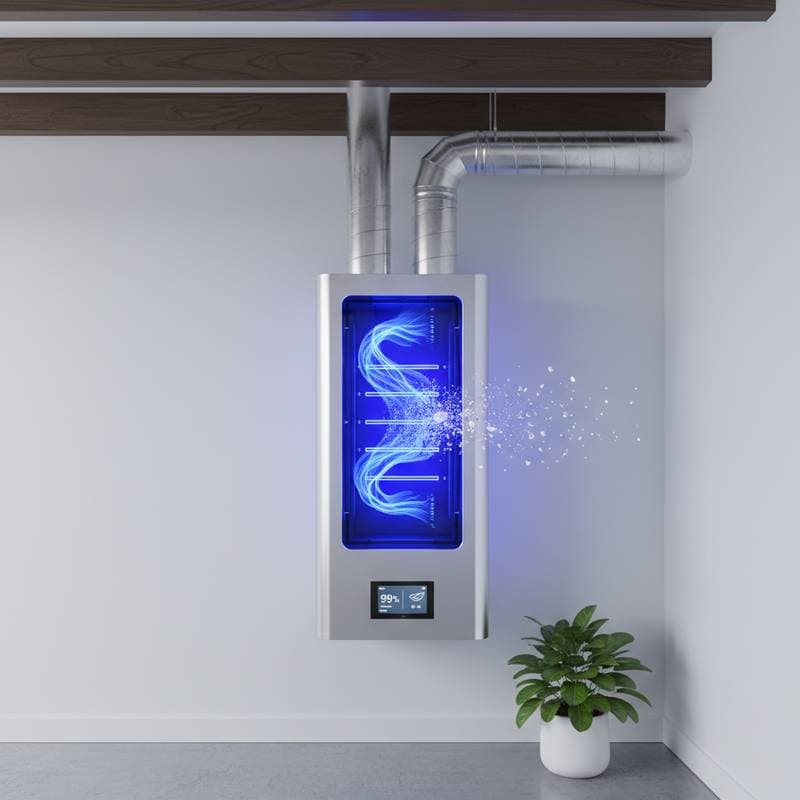UV-C Purifiers: The New Standard for Clean Home Air
UV-C air purifiers employ ultraviolet light to neutralize airborne bacteria, viruses, and mold spores directly within the HVAC system. These devices target microorganisms at the molecular level, which results in cleaner and safer air distribution throughout the home. For individuals seeking a dependable method to minimize allergens and contaminants, UV-C purification emerges as the prevailing standard for superior home air quality.
| Feature | Typical Benefit |
|---|---|
| Average Installation Cost | $400 - $700 |
| Maintenance Cost per Year | $50 - $150 |
| Lifespan of UV Bulbs | 9 - 12 months |
| Effectiveness Against Germs | Up to 99% reduction in microbes |
| Best Installation Location | Inside HVAC air handler or near coils |
Average UV-C Purifier Costs
The installation of a UV-C air purifier generally ranges from $400 to $700, influenced by the system type and selection between a coil sterilization light or an air sterilization system. Entry-level models suited for smaller HVAC setups begin at approximately $300, whereas advanced dual-lamp or comprehensive whole-home units surpass $900.
Maintenance expenses remain low, primarily involving annual UV bulb replacement at $50 to $150. Engaging a professional for installation guarantees appropriate positioning and electrical connections, essential for optimal performance and safety.
Key Factors That Affect UV-C Purifier Price
Multiple elements determine the total expense of integrating a UV-C air purifier into an HVAC system.
Type of UV-C System
- Coil Purifiers: Positioned adjacent to the evaporator coil, these units inhibit mold and algae accumulation. They prove more economical, with average costs around $400.
- Air Purifiers: Placed within return ducts, these systems disinfect circulating air. Although they incur higher costs, they address greater air volumes effectively.
System Size and Compatibility
HVAC systems of larger scale demand more powerful or additional UV-C lamps to ensure comprehensive airflow coverage. Homes with multiple air handlers might require several purifiers, thereby elevating the total investment.
Installation Complexity
Compact HVAC configurations or those without straightforward access points extend installation time and labor charges. Conversely, setups featuring readily accessible ducts facilitate quicker and less costly procedures.
Brand and Build Quality
Higher-end models provide superior durability, extended bulb longevity, and built-in safety mechanisms such as automatic shutoffs. Despite the initial premium, these options yield enhanced value over time via improved efficiency and dependability.
Types of UV-C Air Purification Systems
Various UV-C purifier options exist, tailored to specific home configurations and air quality requirements.
-
Coil Sterilization Units: These mount near the evaporator coil to maintain moisture-vulnerable zones free of mold and biofilm.
Pros: Requires minimal upkeep; effectively curbs microbial growth on coils.
Cons: Focuses solely on coil sanitation, excluding broader air treatment. -
Air Sterilization Units: Installed in return ducts, these treat air in motion prior to home-wide distribution.
Pros: Reduces airborne pathogens efficiently; aids those with allergies.
Cons: Entails moderately elevated installation expenses. -
Portable UV-C Purifiers: Independent devices that sanitize air in designated rooms.
Pros: Offers placement versatility; eliminates need for permanent setup.
Cons: Provides restricted coverage; underperforms for whole-home needs.
Signs You Need a UV-C Purification System
Certain indicators suggest that a UV-C air purification system would enhance home air quality.
- Persistent musty odors emanating from air vents
- Recurrent indoor allergy or asthma episodes
- Mold proliferation on or around HVAC elements
- Excessive dust accumulation despite routine cleaning
- Rapid illness transmission within the household
- Diminished HVAC performance or airflow from microbial deposits
Such symptoms typically reveal that the air system recirculates pollutants rather than eliminating them.
The UV-C Purifier Installation Process
A professional approach to installation safeguards the UV-C system's safety and efficacy. The process unfolds as follows:
- Inspection: The technician assesses the HVAC setup to identify the optimal mounting location.
- Selection: The appropriate UV-C model aligns with system dimensions and objectives.
- Mounting: The lamp enclosure secures firmly near coils or within air ducts.
- Wiring: Connections integrate with a dedicated power supply or HVAC controls.
- Testing: Functionality of the lamp confirms, alongside checks for air leaks or electrical faults.
- Maintenance Guidance: Instructions cover system monitoring and bulb replacement schedules.
UV-C Purifier Labor Costs
Labor fees for UV-C purifier installation span $100 to $250, varying with access ease and wiring demands. A certified HVAC specialist ascertains precise alignment and placement, vital for thorough sterilization. DIY efforts pose risks including electrical hazards and warranty invalidation, rendering professional service advisable.
Frequently Asked Questions About UV-C Purifiers
How does a UV-C air purifier work?
A UV-C purifier emits short-wave ultraviolet light that deactivates microorganisms by damaging their DNA. Positioned inside the HVAC system, it sanitizes passing air, thereby curbing the dissemination of bacteria, mold, and viruses.
Is UV-C light safe for my home?
UV-C light poses no risk when properly installed within the HVAC unit. Containment within the system prevents exposure in occupied spaces, with professional setup ensuring adequate shielding.
Do UV-C purifiers remove dust or pet dander?
UV-C systems target biological agents rather than physical particles such as dust or pollen. Optimal outcomes arise from combining UV-C with high-efficiency filters or supplementary air cleaners.
How often should I replace the UV bulb?
UV-C bulbs typically endure one year before efficacy wanes. Consistent replacement sustains peak performance and inhibits microbial resurgence.
Can UV-C purifiers help with allergies?
UV-C purifiers mitigate allergy symptoms by neutralizing airborne allergens like mold spores and bacteria. While they complement filters in particle capture, this biological disinfection fosters a less reactive indoor environment for sensitive individuals.
Do UV-C systems increase energy use?
UV-C systems draw minimal power, comparable to a standard light bulb, and impose negligible impact on overall HVAC energy consumption. Their role in preserving coil cleanliness can enhance system efficiency, potentially lowering long-term energy demands.
Steps to Achieve Cleaner Indoor Air
To pursue healthier air, consider integrating a UV-C purifier into your HVAC framework. This upgrade operates unobtrusively to safeguard air quality, curb germ proliferation, and promote respiratory well-being for all occupants.





